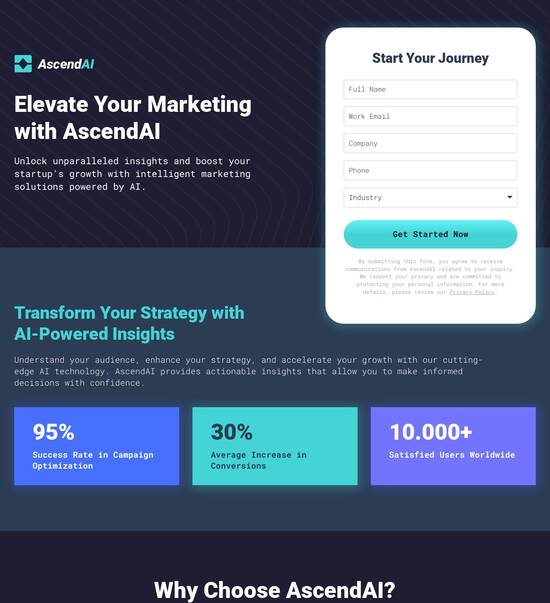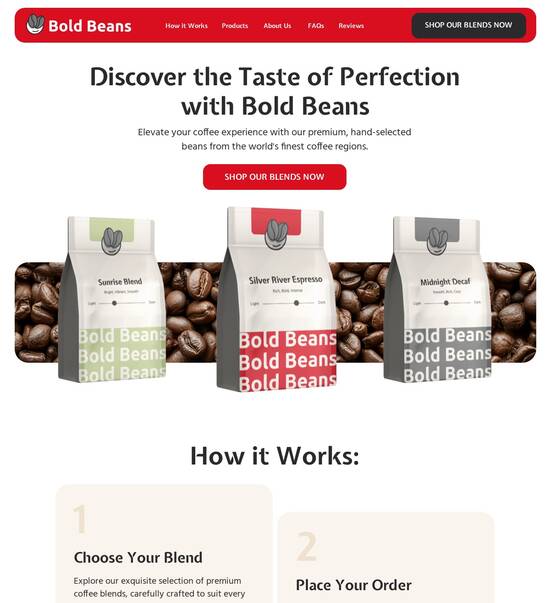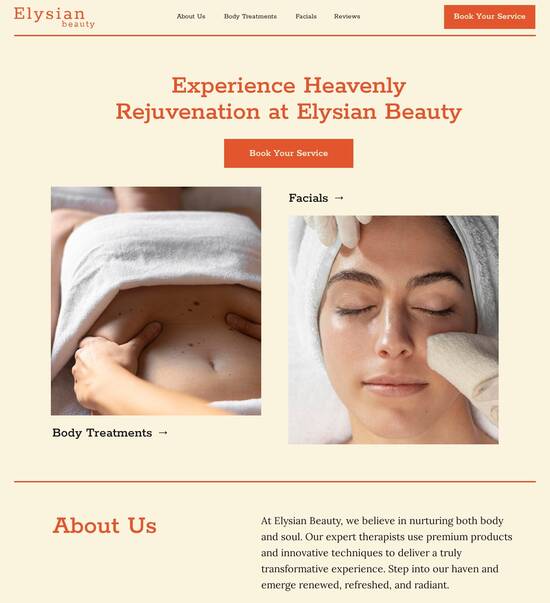
Static user profile page template
Explore Similar TemplatesAbout template
Unleash your creativity with the static user profile page template. Try Instapage today.
Recommended templates

Easy to build without coding
With the intuitive drag-and-drop builder, anyone on your team can create high-converting pages without any knowledge of code or design. Make enhancements to your landing page with custom widgets using Javascript, HTML/CSS, or third-party scripts.

Multiple layouts for any industry and goal
Select from 500+ landing page layouts built to boost conversions across industry-specific scenarios. Customize them by adjusting fonts, adding images, and generating on-brand content with the AI assistant. Quickly scale with Instablocks® and Global Blocks that you can save, reuse, and update globally.

Loads fast and looks polished on any device
Every template is responsive, which means they present professionally on any device and load blazingly fast with our Thor Render Engine. You can also power them up with Google AMP technology to deliver an unparalleled mobile experience and drive higher conversions.

Robust analytics & experimentation
Get real-time updates and reporting across all your devices, showing the number of visitors, conversions, cost-per-visitor, and cost-per-lead. Launch AI-powered experiments, run A/B tests, and use heatmaps to analyze user behavior, then optimize your landing page to maximize conversions.







Easy to build without coding
With the intuitive drag-and-drop builder, anyone on your team can create high-converting pages without any knowledge of code or design. Make enhancements to your landing page with custom widgets using Javascript, HTML/CSS, or third-party scripts.
Multiple layouts for any industry and goal
Select from 500+ landing page layouts built to boost conversions across industry-specific scenarios. Customize them by adjusting fonts, adding images, and generating on-brand content with the AI assistant. Quickly scale with Instablocks® and Global Blocks that you can save, reuse, and update globally.
Loads fast and looks polished on any device
Every template is responsive, which means they present professionally on any device and load blazingly fast with our Thor Render Engine.
Robust analytics & experimentation
Get real-time updates and reporting across all your devices, showing the number of visitors, conversions, cost-per-visitor, and cost-per-lead. Launch AI-powered experiments, run A/B tests, and use heatmaps to analyze user behavior, then optimize your landing page to maximize conversions.
All the features you need to build lead-generating landing pages
Explore more featuresLearn how to build top-performing landing pages for any goal
FAQs
Leading the way in building high-performing landing pages





A step-by-step guide to leveraging Instapage for effective landing pages
Creating high-converting landing pages is crucial for optimizing your marketing efforts. Instapage, the most powerful landing page and conversion rate optimization (CRO) platform, offers a comprehensive solution to maximize your return on investment (ROI) for digital marketing campaigns. This guide outlines how to utilize Instapage's features effectively to enhance your landing pages.
Understanding the power of Instapage
Instapage provides businesses with an all-in-one platform designed to create highly effective landing pages quickly. Its extensive library of 100+ ready-to-use templates means you won’t need to start from scratch. These templates incorporate the latest conversion optimization techniques, allowing you to launch campaigns without the need for coding knowledge.
- High-converting templates: Select from a variety of templates that have been tested for maximum conversions.
- Lead generation tools: Access pre-built lead generation elements that integrate seamlessly into your pages.
- Intuitive builders: Use drag-and-drop tools to customize your landing pages easily, catering to your specific audience.
Creating your first landing page with Instapage
To get started, you first need to choose a template that aligns with your campaign goals. Follow these steps to create your landing page:
- Choose a template that resonates with your target audience and the objectives of your campaign.
- Customize the elements on the template using Instapage's intuitive builder, adding images, text, and forms as needed.
- Preview your page to ensure everything is aligned correctly before publishing.
Optimizing your landing page for conversions
Once your landing page is live, it’s essential to ensure it is performing optimally. Here are strategies to enhance performance:
- Use A/B testing: Implement A/B tests on different versions of your landing page to determine which design converts better.
- Analyze heatmaps: Review detailed heatmaps to see where users are engaging most and adjust content accordingly.
- Track performance: Utilize the analytics dashboard to gather insights on your landing page performance over time.
With these steps, you can effectively manage and optimize your landing pages on Instapage to meet your marketing goals.
Remember that ongoing optimization is key to success in digital marketing. Regularly review your landing pages, test new strategies, and adapt your approach based on user feedback.
Ready to transform your digital campaigns? Start using Instapage today and experience the difference in your marketing results.
People also ask about Static user profile page template
Static user profile page template: A comprehensive guide
The essence of a static user profile page template
A static user profile page template serves as a foundational element in web development, allowing users to present information about themselves in a fixed format. Unlike dynamic profiles that can change based on user interactions and backend databases, static user profiles are often HTML-based and remain constant unless manually modified. This stability ensures that a user's information is consistently presented, which is essential for creating a reliable online presence.
The significance of a user profile cannot be overstated, especially in platforms where personalization enhances user experience. Static profile pages serve as introductory portals, fostering connections and trust within communities, whether in professional networking or knowledge-sharing platforms.
Definition and comparison between static and dynamic profiles.
The role of user profiles in establishing an online identity.
Crafting an effective user profile
An effective user profile page encompasses several key components that communicate the individuality and professionalism of the user. Starting with essential elements, the profile picture and user bio are pivotal; they form the first impression and provide a snapshot of the user’s personality and interests. Additionally, contact information and location fields facilitate communication, enhancing the profile's utility for networking.
Career details and work history sections play a crucial role in demonstrating professional experience and skills. These components work together to convey a clear message about who the user is, their achievements, and how potential collaborators or employers can reach out.
Profile picture and engaging user bio.
Detailed contact information and geographic location.
Career history highlighting relevant work experience.
In addition to basic information, it’s essential to showcase skills and expertise meticulously. Highlighting qualifications, certifications, and specialized knowledge can significantly enhance the credibility of a profile. Customizing sections to reflect in-depth knowledge allows users to share not just achievements but also aspirations and ongoing projects.
The role of HTML in developing user profiles
HTML is the backbone of any static user profile. Utilizing essential HTML elements like semantic tags ensures that content is structured logically, which is crucial for accessibility and search engine optimization. Structuring profile content not only helps screen readers interpret the page but also enhances the overall user experience.
Forms are invaluable for user interaction, allowing visitors to reach out or even submit feedback. Using forms effectively can add depth to static profiles, transforming them into platforms for engagement rather than just presentation.
Importance of semantic HTML tags for structure.
Interactive forms to facilitate connection.
Moreover, aesthetics play a vital role when developing user profiles. CSS can be leveraged to create visual appeal through styling assignments, ensuring that profiles not only convey information but also engage viewers. Responsive design considerations are vital here, ensuring that users on mobile devices have an equally enjoyable experience.
Leveraging static user profiles in Q&A communities
In Q&A communities, static user profiles build trust through transparency. Users value profiles that convey authenticity, and the psychological effect of a well-crafted profile can lead to greater interaction within the community. A complete profile can serve as a reassurance to other users, making them more likely to engage, ask questions, or provide answers.
Additionally, showcasing contributions can significantly enhance a profile's value. Profiles can integrate user-generated content, highlighting questions answered or projects completed, which not only serves to build credibility but also to celebrate community contributions.
Trust-building through detailed profiles.
Integrating community contributions to showcase expertise.
The networking potential of static user profile pages
Static user profile pages are a gateway for connecting developers and users. The importance of networking in professional advancement cannot be overstated, and a polished profile can open doors to new opportunities, collaborations, and mentorship. Profiles can serve as digital business cards, showcasing skills and fostering valuable connections in the tech space.
Employing best practices for networking is essential. Effective profiles should include links to other professional social media accounts, facilitating connections with employers and peers. Encouraging connection requests and fostering collaboration can enrich the professional landscape for users, making static profiles a vital part of their online personas.
Linking to social media profiles for broader networking.
Encouraging collaboration requests and networking opportunities.
Navigating user profiles: Frequently asked questions
Setting up a static user profile page can seem daunting, but it is straightforward. Utilizing HTML and CSS allows developers to create custom profiles tailored to specific requirements. Choosing a template and adapting it to fit personal branding can streamline the process and ensure consistency.
However, static profiles have limitations compared to their dynamic counterparts. Their inability to change based on user input or engagement can be a drawback in fast-paced environments. Understanding these limitations helps set realistic expectations for users looking to build a solid online brand.
Steps for setting up a static user profile page.
Understanding limitations compared to dynamic profiles.
Addressing concerns about security and privacy is crucial when navigating user profiles. Developing a strategy to safeguard personal information and communicating transparently about data usage can significantly enhance user trust. Highlighting the importance of user consent can further ease concerns, making users more comfortable with engaging with profiles.
Expanding the scope: Future of static user profiles
The future of static user profiles is set to evolve with emerging trends in web development. Integration with AI technology is likely to create personalized experiences, enhancing user engagement by offering dynamic content that resonates with individual users. The capability for personal websites to adapt based on user interactions may change how users perceive static profiles, making them more interactive.
Community improvement strategies should focus on encouraging feedback and participation. Bringing user insights into refining profile features can significantly enhance functionality and relevance, ensuring that profiles remain valuable in a rapidly changing digital landscape.
Emerging trends in AI integration with profiles.
The need for continuous user feedback for enhancements.
Case studies: Successful implementations of static user profiles
Analyzing successful applications of static user profiles reveals valuable insights. Thriving Q&A communities often feature user profiles that are both aesthetically pleasing and rich in content. These profiles typically highlight expertise and community contributions, showcasing the users’ best attributes and driving engagement.
Career progression has been directly linked to robust user profiles. Many professionals benefit from enhanced visibility and recognition within their industries due to carefully crafted profiles. These case studies provide developers with essential lessons on user engagement strategies and effective profile development.
Examples of successful Q&A communities with strong user profiles.
Insights on career growth attributed to profiles.
Tools and resources for developers
Various tools and resources provide significant support for developers in creating static user profiles. Software and libraries, such as Bootstrap or Foundation, can streamline the HTML and CSS development process, enabling rapid user profile creation while ensuring responsiveness and functionality.
Networking communities, such as GitHub and Stack Overflow, offer platforms for knowledge sharing and collaboration. These resources not only enhance skills but also facilitate connections with industry peers, aiding in career advancement and professional growth.
Frameworks aiding in HTML and CSS development.
Networking platforms for knowledge sharing and career growth.
Ready to skyrocket conversions?
Supercharge your ad campaigns with high-performing landing pages
Get started














